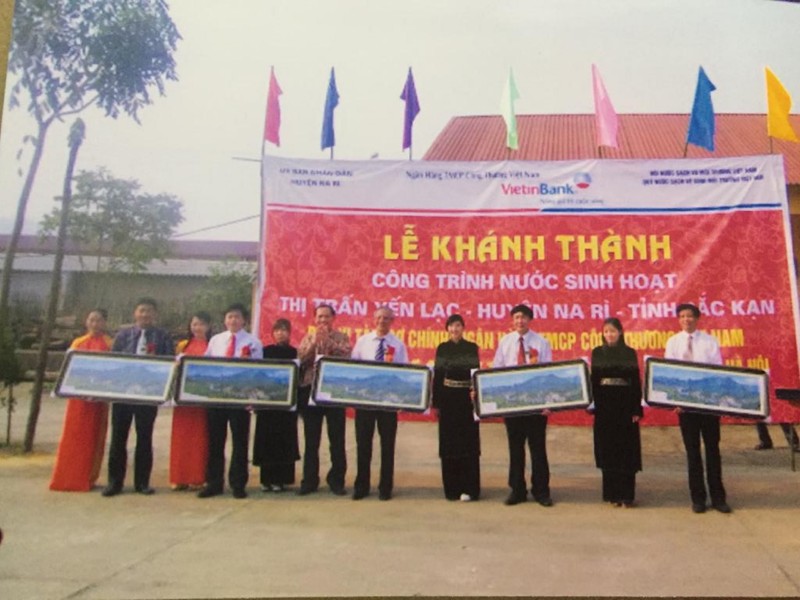Sticky rice Mai Châu: Sticky rice is a common substitute for rice in the Tây Bắc area. Called “kháu càng nòi” in Thai, which translates to soft, aromatic rice, one can only experience the fine taste of this dish by enjoying sticky rice directly made by the Thai women in Mai Châu.
The Thai people always opt for “nếp nương" to make sticky rice. It is a type of glutinous rice grown by the Thai on terraced fields in Mai Châu valley. The rice is soaked for hours to soften before cooking. Thai women do not cook sticky rice using metal pots and steamers like the Kinh, but instead use a wooden steamer. Rather than being boiled, the rice cooks itself using steam, then is removed into a basket when it releases an abundance of fragrance. However, at this point, the rice is yet to be completely cooked. The sticky rice is mixed in the basket for a while and then put back into the steamer to sit until thoroughly cooked. Each grain of rice is cooked to a shine, with an aroma inviting to the smelling senses of the diners. This sticky rice is typically eaten alongside grilled dishes including mountain chicken, fish from the river, or pork from the village.
According to the Thai, sticky rice is best enjoyed with sesame salt. It is only by taking a bite of rice dipped in sesame salt that one can fully experience the aromatics and sweetness of the rice plant. The double-steaming method, in particular, creates a soft and supple rice. When the rice is squeezed, rolled into a round ball intertwining all the grains, none sticks to the hand.
Mai Châu “Lam” Rice: The ingredients needed for lam rice include rice, bamboo tubes, and banana leaves. Additionally, coconut shavings, coconut milk and sesame can be mixed with the rice before grilling. The bamboo used is from the “Pá Ngá” tree, a medium-sized, even tree with a thin, paper-like white layer inside (the hollow tube has a diameter of 3-5cm). The immature bamboo tree is cut into tubes just before growing leaves and filled with glutinous rice, which is soaked and covered in water for approximately 3-4 hours. Dong and banana leaves are used to seal the openings of the tubes, which are then transferred to a grill (they can be cooked over fire, but they must be turned regularly to prevent burning). When the water inside has evaporated, the cooked lam rice is removed to cool. An outside layer is sliced off to leave a thin bamboo layer, which is then cut into segments. The rest of the bamboo casing is only peeled off when the rice is consumed, as to ensure the rice stays soft and silky. Lam rice made with bamboo should not be cooked over fire, but turned evenly over coal, as the thin layers of bamboo would burn quickly before even allowing the rice inside to cook completely. Other than pairing lam rice with sesame salt, another classic combination that cannot be missed is the traditional seasoning of the Thai, called “chẩm chéo”.
Mai Hạ Wine: The secret to making quality Mai Hạ wine lies in the fermentation of the leaves. The minimum ingredients needed for fermentation are nine types of wild leaves found in forests, which are called herbs by the natives, including: guava, grapefruit, bell, nhong nhanh, wampee, nhut meo, pha nooc, cu din, etc. This blend of leaves is mashed with two types of ginger which are pureed to smooth, each with a specific proportion. This mixture is then fermented for around three days. Combine the ingredients with this fermented mixture, and then shape into disks. Continue to let ferment for another three days until the disks turn an opaque white. Distill using the appropriate pot. The steam will condense into drops and trickle into the bottle.
Mai Hạ wine is thick, burning blue when poured onto a porcelain dish. Only anyone used to the alcohol concentration and yeast of this strong wine would be able to handle it, or else the wine burns all through the throat. This wine is effective for and primarily used to soak medicine. Mai Hạ wine is crystal clear to the point it cannot possibly be any clearer. It only takes a light shake for the floss of the wine to stick to the bottle's neck, before it dissolves after a long time. Before the wine cup even touches one's lip, the fragrance of the wine would fill the air. Mai Hạ wine, in general, can reach over 50. The wine is strong but not “jolting". Just contact with the tip of the tongue would send the alcohol dissolving quickly down one's throat. Only a little wine would cause someone’s insides to flutter. Mai Hạ wine is not for savoring, and most definitely not to down all at once.
Boiled man pig: The Man pig is raised freely, then cut open to remove blood and insides, shaved off and washed until clean. People tear the pork to simmer over fire until just cooked, and after that, sliced thinly and plated on top of wild banana leaves. This piping hot dish that brings ample fragrance when dipped into salt and finely chopped roasted doi nuts will make you heads-over-heels for the sweetness of the meat and the crispy, rich pork rind.
Sour-marinated river fish: This is a long-existing dish that remains an essential part of the Tet meal of the Thai. From lunar August to October, the Thai have to catch “pa va" fish at the rivers, which resemble carp but are smaller inside, then bring them home to clean, butcher into parts and combined with seasoning like salt, chili powder, garlic, ginger, lemongrass, roasted rice, and a touch of wine. The marinated fish is then needed to be sealed into bamboo shoot tubes for a month before it is ready for use. However, if it sits for a few months longer, then the fish would be much more tender and delicious. Especially when drinking wine and eating sour-marinated fish, fig leaves and a side of sticky rice cannot be missed to elevate the dish to a deep and unforgettable taste.
Ha Hoai Le
Source: www.ipahoabinh.gov.vn





